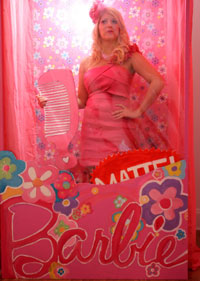Barbie art and Innocent youth
Barbie art and Innocent youth

Mattel's classic Barbie doll, a much loved, sometimes hated, icon of American girlhood, is way more than a toy.
Since her introduction in 1959 the pampered in pink plaything has been a force in American culture but surrounded as much by controversy as all her pretty clothes.
Though marketed as wholesome, Barbie has been criticized as too thin, too busty, too racy (a 2009 model had tattoos), and too shallow (a talking 1992 doll once famously said "I love shopping" and "math class is tough.")
In "Think Pink: Explorations of My World," Rowan art major Trisha Glowacki took a mixed media approach to examine all things Barbie and even joined the show herself.
"When people came into the room I kind of just stood there," said Glowacki, 23, who built a life-sized Barbie "box," dressed herself like Barbie and got in it. "Two little girls came in and were totally convinced I was Barbie."
In addition to the performance piece, Glowacki, who graduated in May, employed paintings, sculptures and photographic pieces to examine Barbie's impact and influence.
She noted that since the doll's introduction, Barbie has been held up as a model that girls and young women can do anything, as long as they fit a mold. So there's been astronaut Barbie, doctor Barbie, even NASCAR Barbie, all of them dressed in pink.
The exhibit literally examined that mold with 78 plaster cast Barbies, roughly half pink and half white, with one yellow doll off in a corner.
"The rest of the dolls are blocking out the deformed one," Glowacki said. "There can be different ways to see things. It just depends on how the viewer wants to see them."
Though they weren't planned together, Glowacki's "Think Pink" and Rachel Shoemaker's "Innocent" seem natural companions and compliment one another at the gallery.
Shoemaker, 25, a senior art major, also took a mixed media approach as she examined the fleeting nature of childhood.
Her works include photo collages, video, sand and water play boxes, plaster casts and a block set.
"The theme is childhood innocence and how, from early childhood, we start to lose the innocence we're born with," Shoemaker said.
Shoemaker, an aspiring Baptist missionary who has travelled to Africa and the Caribbean on mission trips with her church, said the inevitable loss of innocence is universal but she sought to preserve it.
"I love to watch how children explore their world," she said. "The parents of all of these children are my friends so with the photos and video I wanted to capture their innocence."
Rowan's High Street Gallery, 11 East High Street in Glassboro, is a student-run and operated space dedicated to the University's student artists.
The gallery is open Wednesday through Friday between 3:30 and 7:30 p.m. and Saturday from 12:00 to 4:30 p.m. Admission is free.
